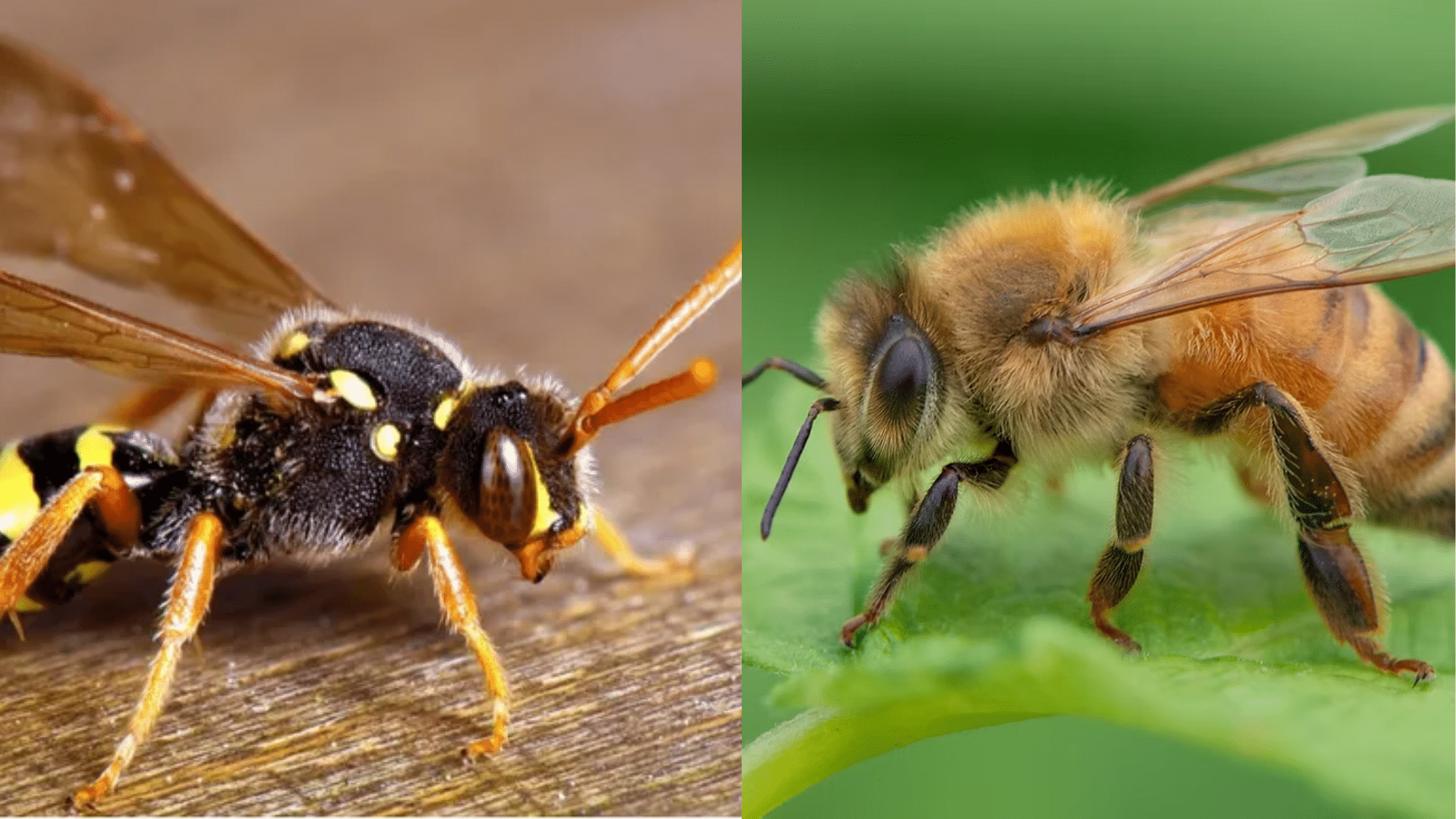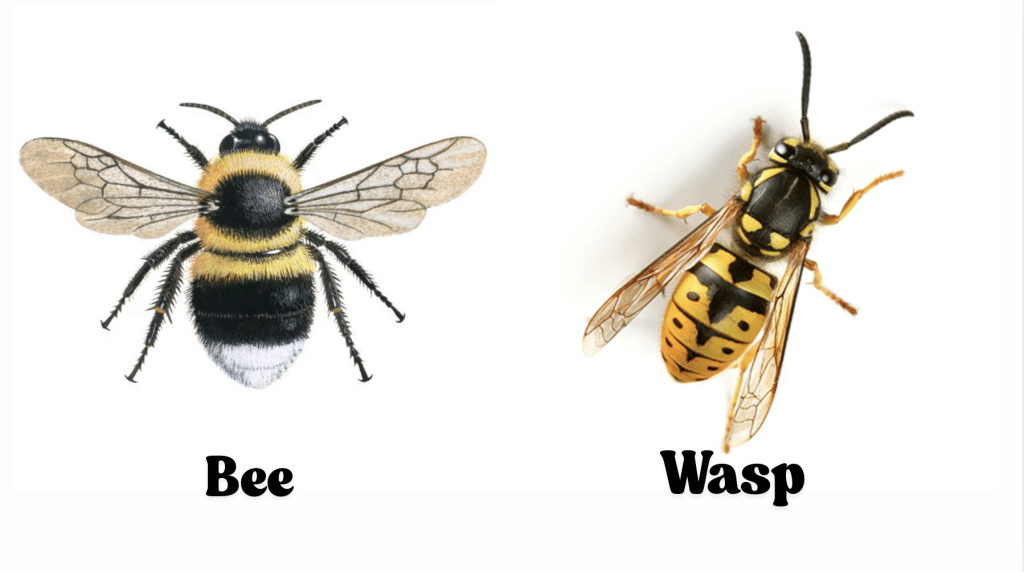Ever spotted a buzzing insect and been confused about whether it was a bee or a wasp? Well, you’re not alone in this trouble!
Those yellow and black flyers may look quite similar from a distance, but knowing which is crucial for many reasons.
So, this blog will walk you through the key factors that distinguish bees and wasps.
By the end, you’ll be able to spot the differences quickly and know exactly what you’re dealing with the next time one flies by.
Contrasting Body Features of Bees and Wasps
| Characteristic | Bees | Wasps |
|---|---|---|
| Body Shape | Round, fuzzy, plump, and soft bodies that help collect pollen. | Smooth, shiny bodies with a narrow waist and “pinched” look. |
| Hair | Covered in tiny bristles that trap pollen as they move from flower to flower. | Almost hairless with a glossy outer shell. |
| Color Patterns | Muted, brownish-yellow tones with yellow and black markings. | Bright, bold black and yellow patterns. |
| Size | Typically under an inch long. | Generally larger, with many species reaching 1.5 inches in length. |
1. Behavior and Diet Differences to Identify
The way bees and wasps act and what they eat might surprise you. These habits make them distinct creatures, despite their similar appearances.
Eating Habits
Bees feed mainly on nectar and pollen from flowers. They collect these plant foods to make honey and feed their young.
Wasps have a much more varied menu. While they also enjoy nectar, many wasps hunt other bugs. They catch flies, caterpillars, and spiders to feed their babies. Some wasps even scavenge for meat and sweets at your picnics.
Social Life
Most bees live in groups, and each bee has a distinct role in the colony. The queen lays eggs, workers gather food, and males assist in colony growth.
Some wasps live alone, while others form groups. Yellow jackets and hornets build large family units, but many wasp types prefer the solo life.
These behavior patterns explain why you might see these insects in different places performing various tasks.
2. Nest Building and Habitat Preferences
Bees and wasps create very different homes using unique building methods. Let’s examine where they live and how they build their nests.
Bee Homes
- Create structures using beeswax produced from their bodies
- Build perfect hexagonal cells that connect into honeycomb patterns
- Store honey, pollen, and larvae in these cells
- Honey bees prefer enclosed spaces like hollow trees or man-made hives
- Bumblebees often use existing cavities, such as mouse holes and under sheds.
- Mason bees use mud to build homes in small tubes or holes
Wasp Homes
- Construct nests using wood fibers mixed with saliva to create a paper-like material
- Build umbrella-shaped or football-shaped structures with cells inside
- Paper wasps create open-faced nests with visible cells
- Yellow jackets and hornets build enclosed nests with an outer paper covering
- Often choose sheltered spots: eaves, tree branches, attics, wall voids
- Some ground wasps dig tunnels in soil rather than building paper structures
Defense Strategies of Bees and Wasps

Did you know a honey bee pays the ultimate price for stinging you? Once their barbed stinger lodges in your skin, they can’t pull it out.
The bee flies away, leaving behind part of its body, which leads to its death. This makes bees think twice before attacking.
Wasps? They face no such limitations. Their smooth stingers slip in and out with ease, allowing for multiple strikes during one encounter. No wonder they seem more ready to attack!
How About Their Personalities
- Bees: Generally peaceful unless their home faces direct threats
- Wasps: Often territorial and quick to defend their space
When a bee feels threatened, it might try to warn you first. You’ll notice it buzzing around your head or even gently bumping into you, basically saying, “Please go away!”
Wasps skip the pleasantries. Their first response often jumps straight to attack mode, especially if you’re near their nest.
These different approaches explain why many people fear wasps more than bees, despite both being capable of delivering painful stings.
Ecological Importance of These Insects
Both bees and wasps play crucial roles in our world, though each contributes in different ways.
1. What Bees Do for Plants
Bees rank among the top plant helpers on Earth! As they visit flowers for nectar, pollen sticks to their fuzzy bodies.
This pollen transfers between flowers, enabling plants to produce fruits and seeds. Without bees, many foods we enjoy would become rare or disappear.
2. How Wasps Help Gardens
Wasps serve as nature’s pest control team. They hunt caterpillars, flies, and other bugs that damage garden plants.
A single wasp colony can catch thousands of insects in just one season! This natural pest management approach keeps plants healthier without the use of chemicals.
3. Beyond the Obvious Roles
- Bee hives create safe homes for other helpful creatures
- Wasp nests break down into natural materials when abandoned
- Both insects become food for birds, spiders, and other wildlife
4. Local Plant Success
When native bees and wasps grow in an area, local plant species also grow better. This creates a chain reaction of benefits for all wildlife in the area.
Next time you see a black and yellow visitor, check for these clues: fuzzy body means probably a bee, smooth, thin waist suggests a wasp, hanging paper nest points to wasps, and hexagonal wax cells are bee territory. Remember to stay calm around them. They’ll rarely bother you unless their homes face danger.















